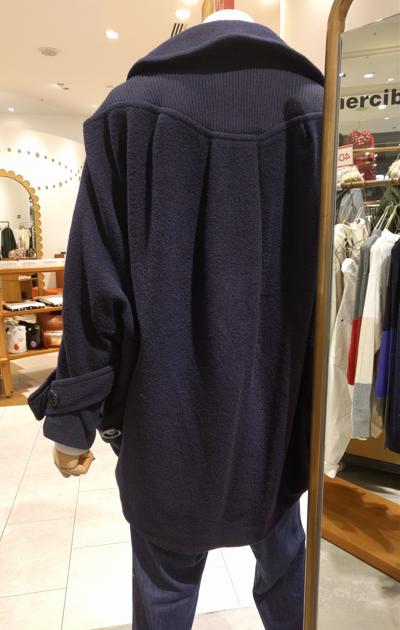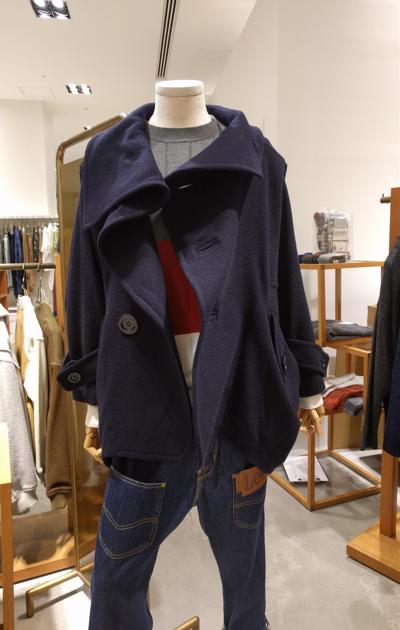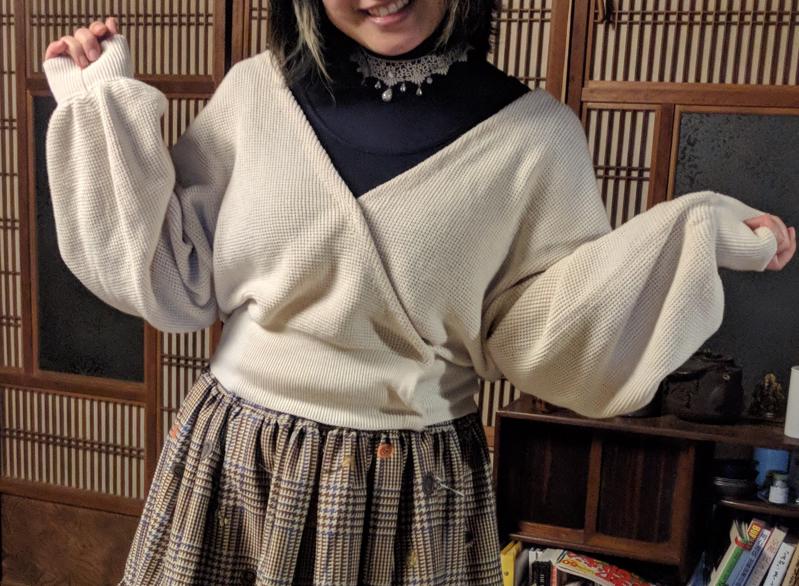Pheasants are like peacocks, right? 雉始雊 The Pheasant's First Calls (January 16-20)
January 15, 2018
|
Tokyo
Ok, this is the last set of Tokyo photos and I'm trying to make the theme work. Broad strokes.
Saw this beautiful unisex coat in a store in Tokyo. Wasn't willing to pay the price on that price tag, but I took enough photos I think a


skilled cutter would be able to duplicate the pattern with ease. *winkwinknudgenudge*
One thing I've noticed with Japanese clothing is that they are a fan of the "one size fits most" model. This is frustrating for me as someone who has learned and worked with western clothing sizes for years. "Free size" is not a size! Most of the fashion here is baggy, roomy, elastic-waisted...
I suspect it's due to the fact that traditionally, clothing for Japanese people was Kimono, which is indeed one-size-fits-most. The garment itself is meant to be tied on, its width and length adjusted according to the body it must fit. Fabric is not cut off to shape the garment, because that would be a waste of the cut off fabric. If you ever get the chance to open up a kimono sleeve, you'll notice that the curve is formed by gathering the corner on the inside, rather than being cut into a curve. This allows the seams to be taken apart, laundered, and free to be used as starting fabric again, whether to be re-dyed or just put back together for a shorter/taller stature.
Which makes clothing shopping in Japan an adventure of sorts. Of course brands from Europe and America will have their standard sizing, and Japanese clothing stores aimed at the world market will have sized clothing (eg. Uniqlo), but I love shopping at boutiques (yay mediocre fashion snob!) and their clothing is almost always "free size". It's great for bottoms, because that elastic waist sure feels great after a large meal (which you will also not get here, since portion control is huge and some menus let you choose the size of your plate based on weight of rice), but when it comes to tops, this is where I get a bit annoyed.
See, I love fitted coats. I have a body shape that really benefits from a lovely princess seam, and I have some nicely shaped coats. However, the majority of sweaters I purchased in Japan are loose fit, or have large sleeves, or just plain do not fit as a layer underneath the coats I bought along with me.
So for this Winter season, I can either chose to look cute in a loose-knit cardigan, or wear the wool coat I brought with me that actually protects me from the cold.

1.
Foreword
2.
72 Seasons of Japan: 雪下出麦 Beneath the Snow the Wheat Sprouts (January 1-5)
3.
Pheasants are like peacocks, right? 雉始雊 The Pheasant's First Calls (January 16-20)
4.
January 21-24 款冬華 The Butterbur flowers
5.
January 25-29 水沢腹堅 Mountain Streams Freeze
6.
January 30-February 3 鶏始乳 The Hens start laying eggs
7.
February 4-8 東風解凍 Spring winds thaw the ice
8.
February 9-13 黄鶯睍睆 The Nightingale Sings
9.
February 14-18 魚上氷 Fish Rise from the Ice
10.
February 19-23 土脉潤起 The Earth becomes Damp
11.
February 24-28 霞始靆 Haze First Covers the Sky
12.
March 1–5 草木萌動 Plants Show First Buds
13.
March 6–10 蟄虫啓戸 Hibernating Creatures Open their Doors
14.
March 11–15 桃始笑 The First Peach Blossoms
15.
March 16–20 菜虫化蝶 Leaf Insects become Butterflies
16.
March 21-25 雀始巣 The Sparrow Builds her Nest
17.
March 26-30 櫻始開 The First Cherry Blossoms
18.
March 31-April 4 雷乃発声 Thunder Raises its Voice
19.
April 5-9 玄鳥至 The Swallows Arrive
20.
April 10-14 鴻雁北 Geese Fly North
21.
April 15-19 虹始見 The First Rainbow Appears
22.
April 20-24 葭始生 The First Reeds Grow
23.
April 25-29 霜止出苗 The Frost Stops; The Rice Grows
24.
April 30- May 4 牡丹華 The Tree Peony Flowers
25.
May 5-9 蛙始鳴 The First Frogs Call
26.
May 10-14 蚯蚓出 The Earth Worms Rise
27.
May 15-20 竹笋生 Bamboo Shoots Appear
28.
May 21-25 蚕起食桑 The Silk Worm Awakes and Eats the Mulberry
29.
May 26-30 紅花栄 The Safflower Blossoms
30.
May 31-June 5 麦秋至 The Time for Wheat
31.
June 5 - June 9 蟷螂生 The Praying Mantis Hatches
32.
June 10 - 15 腐草為螢 Fireflies rise from the Rotten Grass
33.
June 16 - 20 梅子黄 The Plums turn Yellow
34.
June 21 - June 25 乃東枯 The common Self-Heal Dries (Summer Solstice)
35.
June 26 - June 30 菖蒲華 The Iris Flowers
36.
July 1 - July 6 半夏生 The Crow-dipper Sprouts
37.
July 7 - July 11 温風至 Hot Winds Blow
38.
July 12 - July 16 蓮始開 The First Lotus Blossoms
39.
July 17 - July 21 鷹乃学習 The Young Hawk Learns to Fly
40.
July 22 - July 27 桐始結花 The First Paulownia Fruit Ripen
41.
July 28 - Aug 1 土潤溽暑 Damp Earth Humid Heat (Major Heat)
42.
Aug 2 - Aug 6 大雨時行 Heavy Rain Showers
43.
Aug 7 - Aug 11 涼風至 A cool Wind blows (First Autumn)
44.
Aug 12 - Aug 16 寒蝉鳴 The Evening Cicada Sings
45.
Aug 17 - Aug 22 蒙霧升降 Thick Fog Blankets the Sky
46.
Aug 23 - Aug 27 綿柎開 The Cotton Lint Opens (Limit of Heat)
47.
Aug 28 - Sept 1 天地始粛 Earth & Sky Begin to Cool
48.
Sept 2 - Sept 6 禾乃登 The Rice Ripens
49.
Sept 7 - Sept 11 草露白 Dew Glistens White on Grass
50.
Sept 12 - Sept 16 鶺鴒鳴 Wagtails Sing
51.
Sept 17 - Sept 21 玄鳥去 Swallows Leave
52.
Sept 22 - Sept 27 雷乃収声 Thunder Ceases (Autumn Equinox)
53.
Sept 28 - Oct 2 蟄虫坏戸 Insects hole up Underground
54.
Oct 3 - Oct 7 水始涸 Farmers Drain Fields
55.
Oct 8 - Oct 12 鴻雁来 The Geese Arrive
56.
November 19
Share your travel adventures like this!
Create your own travel blog in one step
Share with friends and family to follow your journey
Easy set up, no technical knowledge needed and unlimited storage!